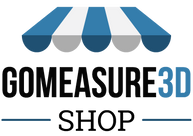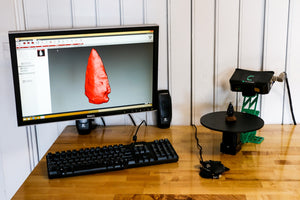Reverse Engineering Organic Surfaces
Dec 27, 2018
OVERVIEW
Sara Forrest, owner and creator of Sara Forrest Design (https://www.saraforrestdesign.com/), has a vision to create jewelry that is inspired from her home in the plains of Kansas. Her stunning pieces resemble the culture of the plains and the history of the land. She approached GoMeasure3D about making a necklace from a special artifact that is 3K to 10K years old. She wondered if it was possible to replicate a arrowhead and to create a casting that mimicked its features. This case study will go over how we were able to help create her vision through reverse engineering of organic surfaces.
Steps for Reverse Engineering
- Scan Arrowhead
- Create CAD from Data
- Cast part from the CAD model

Scanning
Sara found a local man in her hometown who was willing to have his artifact scanned for this project. The arrowhead was made of delicate stone and had distinct features. 3D scanning technology would allow for complete capture of all the details. The arrowhead was scanned with the Metron3D C series scanner in order to collect the data from the geometry of the part. FlexScan3D aggregated the data so that all the details of the arrowhead were clearly preserved. She wanted to capture the history of the part by maintaining the tool marks made by those that created the arrowhead centuries ago. FlexScan3D was successful in saving the intricate geometry as a point cloud.

Creating a CAD Model
NURB Surface being generated over the point cloud in Geomagic Design X.
Once the data has been captured it needs to be turned into a useful CAD model. With a mechanical part, this process usually entails creating each feature by hand. An organic model presents unique challenges as it is not possible to create all the tiny features by modeling it in CAD. Instead we created a NURB (Non-Uniform rational B-spline) surface over the part. Geomagic Design X does this process by mapping out a grid that roughly fits the contours of the organics. How tight or loose the grid fits the actual point cloud is up to the user to determine how accurate the part will appear. For the arrowhead we brought the settings in tight as to keep the details into the final model. Once a solid was generated we added a jump ring to the top of the arrowhead in order for it to hang as a pendant on a necklace.
Final Product
With a complete CAD model, Sara Forrest was able to cast her part in metal for her jewelry store. The casting process maintained all the details from the original arrowhead preserving its beauty and rich history. The hard work of ancient craftsman from centuries ago is now memorialized indefinitely in her pieces. You can see this necklace here (https://www.saraforrestdesign.com/shop-1/great-plains-arrowhead) This is all possible because of 3D scanning technology and its ability to accurately capture the world around us.




